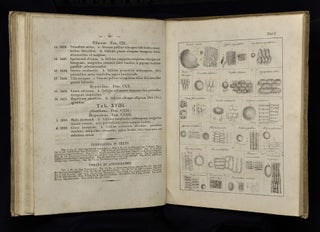De cellulis antherarum fibrosis nec non de granorum pollinarium formis commentatio phytotomica
Vratislaviae (i.e. Wrocklaw, Poland): [Privately published by] J.D. Grueson, 1830. FIRST EDITION. Hardcover. 4to. 58 pp. COMPLETE with 18 lithographic plates. Original nineteenth-century boards (corners and tail of spine bumped), printed label on upper cover. Some minor foxing. An unsophisticated and partially unread copy, with many gatherings unopened. Very good. Item #425
Important and very early work on plant pollens by the brilliant Bohemian polymath Jan Evangelista Purkinje (1787-1869), illustrated with 18 full-page lithographs. According to DSB, Purkinje was inspired by his colleague A.W. Henschel, and "studied plant structures, mainly the elastic fibrous cells of the anthers and the form of the pollen and spores in relation to the mechanism of their dispersion. In his extensive comparative study, combining anatomy with physiology, he distinguished structural types, and drew attention to mechanical factors and the role of cells in the differentiation of plant tissues. His dynamic concept was recognized mainly by French botanists." Purkinje is justly considered to be a pioneer experimental physiologist whose investigations in the fields of histology, embryology, and pharmacology helped create a modern understanding of the eye and vision, brain and heart function, mammalian reproduction, and the composition of cells. REFERENCES: Pritzel 7368. Morton, History of Botanical Science, p. 376. DSB XI, pp. 213-217.
Price: $625.00


